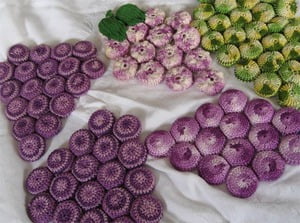The frog eyed gecko is a desert reptile found in many regions. They grow up to six inches in length and are mostly active at night. Pet owners should consider a number of things when caring for one of these geckos. The main concern is the habitat. It should have ample space and environmental conditions that are suitable for the gecko. The health of the gecko should be maintained with a proper diet and medical attention.
Enclosure
Caring for a frog eyed gecko begins with a suitable enclosure. A 20 gallon long aquarium tank is large enough to accommodate two frog eyed geckos. The bottom of the tank should be covered with a substrate. Add about 10 inches of sand or a mixture of sand and loam. This provides a natural footing for this desert gecko. Bury a pile of rocks on one end of the tank, or use a standpipe, to dampen the bottom layer of sand with water. Pour the water over the rocks or into the standpipe. You can add artificial plants and rocks on top of the sand.
Temperature
The temperature of the enclosure should be within an optimal range. One end of the tank should be cool while the other end should be warm. During the day, the cool side should have a temperature around 82ºF, and the warm side should have a temperature between 88 and 94ºF. At night, the temperature should be relatively constant throughout the tank and stay in the upper 60s to low 70s.
During the winter, the frog eyed gecko will be dormant for a five week period. It won’t eat, but will occasionally wake up to drink water. During this time, the temperature in the tank should be cooler than normal. The day time temperature should be in the low 60s, and the night time temperature should be in the 50s.
To maintain the proper temperature, use a heat lamp and undertank heater. It should be on during the day and off during the night.
Diet
The diet of frog eyed geckos is similar to the leopard gecko diet . Both mainly consist of insects. Provide crickets, beetles, mealworms, and earthworms to the hungry gecko. Young geckos should be fed daily, and the insects should not be larger than the size of the gecko’s head. Adult geckos should be fed two to three times a week. Provide mineral supplements with the insects. Dusting crickets with a calcium and phosphorous supplement is a great way to introduce the minerals into the diet.
Behavior
Another important factor in quality frog eyed gecko care is recognizing signs of injury or illness. Normally, geckos are active and resist handling. They move swiftly. Healthy geckos are plump and strong. The first sign that indicates something might be wrong is loss of appetite. Protruding hips, incomplete sheds, and skin wrinkles indicate an unhealthy pet gecko. It is important to take them to the vet to receive a diagnosis and start treatment
Reference:
1. Frog-Eye Gecko.” – Bowling Green State University Biology Dept.
2. Frog Eye or Wonder Gecko Care.” Animal Pets and Friends.
3. “Pet Geckos.” Reptile Channel.

